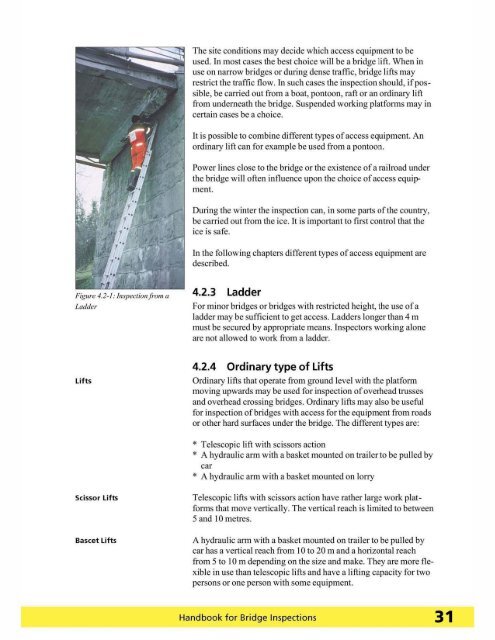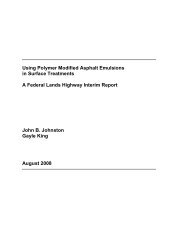Handbook for Bridge Inspections - TSP2
Handbook for Bridge Inspections - TSP2
Handbook for Bridge Inspections - TSP2
You also want an ePaper? Increase the reach of your titles
YUMPU automatically turns print PDFs into web optimized ePapers that Google loves.
The site conditions may decide which access equipment to be<br />
used. In most cases the best choice wi ll be a bridge lift. When in<br />
use on narrow bridges or during dense traffic, bridge lifts may<br />
restrict the traffic flow. In such cases the inspection shou ld, ifpossib<br />
le, be carried out from a boat, pontoon, raft or an ordinary lift<br />
from underneath the bridge. Suspended working plat<strong>for</strong>ms may in<br />
certain cases be a choice.<br />
It is possible 10 combine different types of access equipment. An<br />
ordinary lift can <strong>for</strong> example be used from a pontoon.<br />
Power lines close to the bridge or the existence of a railroad under<br />
the bridge will often influence upon the choice of access equipment.<br />
During the win ter the inspection can, in some parts of the country,<br />
be carried out from the ice. It is important to first control that the<br />
ice is safe.<br />
In the following chapters different types of access eq uipment are<br />
described.<br />
Ladder<br />
fllSpectiolljrOIll (l<br />
4.2.3 Ladder<br />
For minor bridges or bridges with restricted height, the use of a<br />
ladder may be sufficient to get access. Ladders longer than 4 m<br />
must be secured by appropriate means. Inspectors working alone<br />
are not allowed to work from a ladder.<br />
lifts<br />
4.2.4 Ordinary type of Lifts<br />
Ordinary lifts that operate from ground level with the platfonn<br />
moving upwards may be used <strong>for</strong> inspection of overhead trusses<br />
and overhead crossing bridges. Ordinary li fts may also be useful<br />
<strong>for</strong> inspection of bridges with access fo r the equipment from roads<br />
or other hard surfaces under the bridge. The different types are:<br />
* Telescopic lift with scissors action<br />
* A hydrau lic arm with a basket mounted on trailer to be pulled by<br />
car<br />
* A hydraulic ann with a basket mounted on lorry<br />
Scissor lifts<br />
Bascet lifts<br />
Telescopic lifts with sc issors action have rather large work plat<strong>for</strong>ms<br />
that move vert ically. The vertical reach is limited to between<br />
5 and 10 metres.<br />
A hydraulic arm with a basket mounted on trai ler to be pul led by<br />
car has a vertical reach from 10 to 20 m and a horizontal reac h<br />
from 5 to 10m depending on the size and make. They are more fl e<br />
xible in use than te lescopic lifts and have a lifting capacity <strong>for</strong> two<br />
persons or one person with some equipment.<br />
<strong>Handbook</strong> <strong>for</strong> Bri dge <strong>Inspections</strong> 31
















